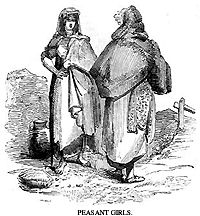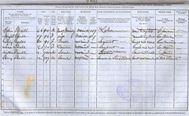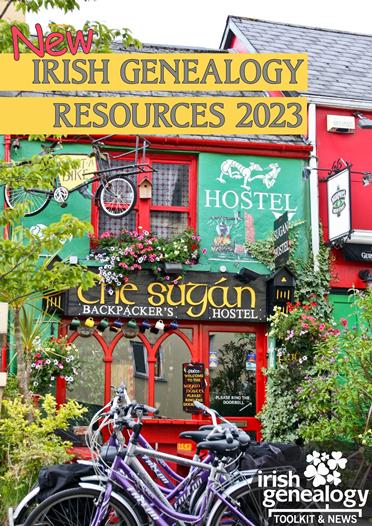- Home ›
- Irish Census ›
- Census fragments
Irish census fragments, 1821-1851
Irish census fragments are exactly that: surviving pages or bits of pages from the original census returns completed in 1821, 1831, 1841 and 1851. On this webpage you'll find out what survives from each of those census years. If you want information about later censuses in Ireland, see the Related Pages menu.
Irish census fragments are exactly that: surviving pages or bits of
pages from the original census returns completed in 1821, 1831, 1841 and
1851. On this webpage you'll find out what survives from each of those census years. If you want information about later censuses in Ireland, see the Related Pages menu.
The first full population census of Ireland was taken in 1821 and set a trend for a series of ten-yearly censuses that continued until 1911.
The first four Irish censuses were arranged by county, barony, civil parish and townland.
1821 Irish census fragments

Who was recorded: Every member of the household was included together with their name, age, occupation and relationship to the head of household.
What was recorded: The acreage held by the head of household and the number of storeys the dwelling had.
What has survived: Some fragments for small parts of counties Armagh, Cavan, Fermanagh, Galway, Meath, and Offaly (then called King's County) are available on the National Archives of Ireland's Genealogy website.
See Resources below.
1831 Irish census fragments
From the papers
"In taking the Census in May Street, Limerick, the Enumerator reports that in one house there are 22 families, comprising 91 persons."
Limerick Chronicle, 29 July 1831
Who was recorded: Every member of the household was included together with their name, age, occupation, religion and relationship to the head of household.
What was recorded: The acreage held by the head of household.
What has survived: Most of the returns (or copies made in 1834) survive for Co. Derry. These are available at the National Archives of Ireland's Genealogy website, and (not online) at PRONI in Belfast and the Genealogical Centre in Derry. See Resources below.
From the papers
"In taking the Census in May Street, Limerick, the Enumerator reports that in one house there are 22 families, comprising 91 persons."
Limerick Chronicle, 29 July 1831
1841 Irish census fragments
Who was recorded: Every member of the household was included in the 1841 Irish census, together with their name, age, sex, relationship to the head of household, occupation, literacy, birthplace and marital status (including date of marriage). This population census also recorded members of the family who were not at home that night including those who had died since 1831.

What the statistics showed: A total island population of 8,175,124, of which only 15% lived in towns.
What has survived: The only original returns to survive are those for parts of Killeshandra, Co. Cavan. These are in the National Archives in Dublin. There are also a number of transcripts of the originals, mostly for locations in the south of Counties Kilkenny and Monaghan, but also for a few isolated households in Counties Cork, Fermanagh and Waterford. All are available at the National Archives of Ireland's Genealogy website (see Resources below).
1851 Irish census fragments
A labourer's 1851 household return
Click on the image above to view an 1851 census return for a labourer's family in Ballinderry, Co. Antrim.
As you can see, Robin and Margaret Hull have four children. Aged 12, the youngest, Harry, is working as a servant in Scotland. The elder boy, William, aged 14, is a linen weaver while sisters Debby and Jane are servants.
Although the parents claim to be literate, they don't seem to have entirely understood all the specified criteria, eg ages and year of marriage.
(Image reproduced with the kind permission of the National Archives of Ireland.)
Who was recorded: Every member of the household was included, together with their name, age, sex, relationship to the head of household, occupation, literacy, birthplace and marital status (including date of marriage). Like the 1841 census of Ireland, absent and deceased members of the family had to be accounted for.
What was recorded: Landholding acreage and a grading system for the standard of houses.
What has survived: Most of the surviving fragments are for Co. Antrim and the single townland of Clonee, Co. Fermanagh. All can be accessed free of charge at the National Archives of Ireland's Genealogy website. They can also be viewed at PRONI in Belfast.
In addition, the NAI website site holds extracts ie transcriptions from some parts of Co. Monaghan as well as lists of heads of households for Dublin City and one ward in Belfast. The Genealogical Office also holds extracts of this population census for some Co. Kilkenny parishes; they're not online.
See Resources below for details of all these repositories.
A labourer's 1851 household return
Click on the image above to view an 1851 census return for a labourer's family in Ballinderry, Co. Antrim.
As you can see, Robin and Margaret Hull have four children. Aged 12, the youngest, Harry, is working as a servant in Scotland. The elder boy, William, aged 14, is a linen weaver while sisters Debby and Jane are servants.
Although the parents claim to be literate, they don't seem to have entirely understood all the specified criteria, eg ages and year of marriage.
(Image reproduced with the kind permission of the National Archives of Ireland.)
What the 1851 Irish census statistics showed: A total island population in the aftermath of the Irish potato famine of 6,552,385 a fall of 1,622,739 in ten years.
The Irish census of 1851 recorded a total of 3,190,630 men and 3,361,755 women. Of the men, 20% were farmers (290,000 with over 15 acres of land; 192,000 of 5-15 acres) while 46% were labourers or herdsmen. Shopkeepers accounted for 3% while there were slightly more (3.3%) employed as cobblers or tailors, and more again (3.9%) were weavers.
Of the women, just under 20,000 (2%) were farmers, 15% were labourers or herdsmen. A similar number to men were shopkeepers, and just under 10% were seamstresses. The biggest groups were the 230,802 domestic servants (24%) and spinners and weavers (15.6%). These figures clearly show the size of the Irish linen and cotton industries in Ireland at this mid-point of the 19th century. (Find out more about the work involved in transforming the flax plant into Irish linen.)
Resources
To access the surviving Irish census fragments and transcriptions of the 1821, 1831, 1841 and 1851 returns:
The National Archives of
Ireland's Genealogy website gives you free access to all surviving pre-1901 census fragments and transcriptions.
Just be sure to choose the correct year at the top of the search box.
The exact same collection of fragments and transcriptions can be searched on FindMyPast, Ancestry and FamilySearch.
While you can consult some of these records at the Public Record Office of Northern Ireland, there is no online access via the PRONI website


